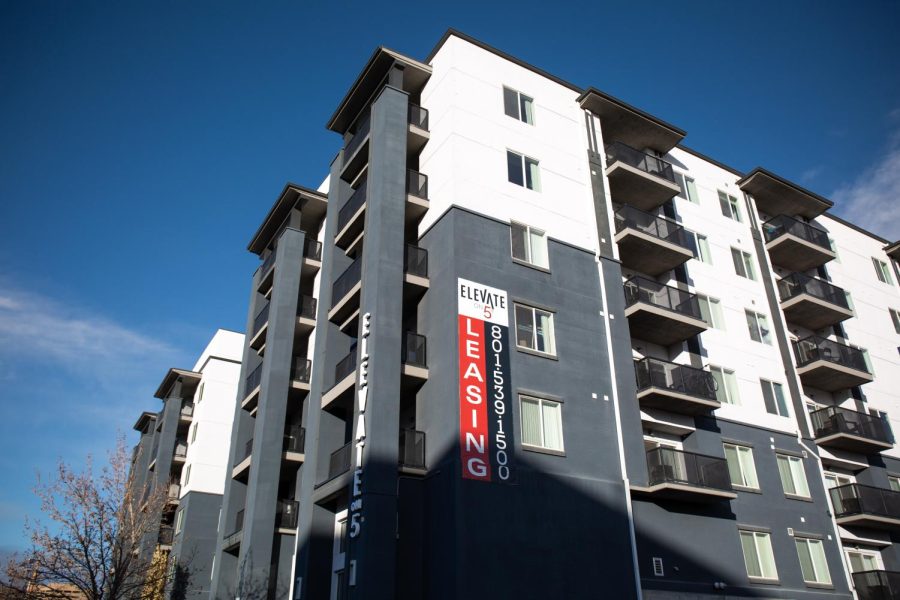Record High Prices Push Salt Lake Renters to Financial Limits
Utah Apartments: Essex, Encore and Elevate on 5, University Blvd, Utah on Nov. 27, 2022. (Photo by Julia Chuang | The Daily Utah Chronicle)
February 9, 2023
When Parker Mortensen’s landlord told them at the end of their lease for a 3-bedroom duplex unit in the Avenues neighborhood that the new price would increase from $1,800 to $2,400, it changed everything.
“We had to seriously reassess all of our finances just to see if we could continue living,” said Mortensen, a Salt Lake City resident. “Doing the same things we’d always done suddenly became expensive. I wasn’t sure if the job I had could continue to support what I was doing.”
Their roommate was priced out by the increase, forcing Mortensen to find a new roommate, since they couldn’t afford rent otherwise.
“What was previously a comfortable living situation became a burden,” Mortenson said. “And the place that I loved living in felt like a luxury all of a sudden.”
Mortensen is far from alone in recently experiencing massive increases in rent.
Average monthly asking rent prices in Salt Lake County are currently at $1,531, about $300 more than at the beginning of 2020, according to Dejan Eskic, a senior research fellow at the Kem C. Gardner Policy Institute. In September 2022, a study conducted by Eskic found the Wasatch Front experienced the same rental price growth in the past two years (2020-22) as the previous 10 years (2010-20).
“It’s not surprising to me, it certainly feels like that’s the case,” Mortensen said. “It feels that bad.”
The reasons for high growth are complex, but Eskic told the Chronicle the main factor stems from Utah housing prices accelerating to record levels throughout the COVID-19 pandemic, causing 76% of Utahns to be priced out of the median-priced home ($519,000 as of Oct. 2022), increasing demand for rental housing.
He also told RadioWest, “If you’re a homeowner, it doesn’t matter; likely your housing costs have improved because interest rates went down in the last year, you were able to refinance. But if you’re a renter, you’re kind of at the mercy of the market.”
In an interview with the Chronicle, Eskic said the numbers from his study are unprecedented but the housing problem faced in Utah and nationally was decades in the making, going back to the baby boom.
“It’s really about demographics, coupled with the pandemic, coupled with fiscal policy,” Eskic said.
He added another factor in this rapid growth in prices is the massive increase in net migration Utah has experienced over the past couple of years.
Since the study was published, Eskic said rental growth in Salt Lake County is beginning to slow, but it’s still very much in a grey area.
“We’re not seeing a drop in rents, but we’re just seeing rents starting to slow and kind of flatten out in some areas,” Eskic said.
On the housing side, he’s seeing clear signs of slowing.
Eskic said the outlook for downtown renting looks slightly different because there are many new units being opened. However, the pandemic hurt the occupancy, because of the increased popularity of working from home and the office market not doing as well.
“I think we will see some opportunities for lower rents or [more] that are offered near the downtown market, but not so much out in the suburbs,” he said.
In 2023, Eskic predicted there won’t be any major dips in rental rates like with housing prices.
“I think the rental market will fare better than the housing market does in terms of fluctuation and prices,” he said.
Mortensen has been renting in Salt Lake for 10 years and enjoys apartment living because they like not being tied down to a specific place. But the more expensive the market gets, the more they see the prospect of buying a home as an act of self-preservation.
“I look at homes and look at their prices and think that’s only going to go up,” they said. “I feel pressured to lock in a bad decision because the market is moving at a pace that doesn’t really align with how I live my life.”
Mortensen, who’s been living in their current apartment for four years, said that, cost aside, their apartment is where they want to live, but it’s hard to feel any stability since the most recent increase.
“I look at things that I could buy like home decor, and I’m like, ‘I don’t know that I want to own more things right now,” they said. “I don’t know that I can put down roots here because it feels like we are one year away, one more rent increase away from me having to totally reconsider my life parameters.”









